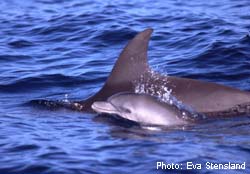Mixed dolphins and the impact of tourism

Dolphins off the coast of East Africa are exposed to a number of threats, like indirect catching, hunting, and environmental impact. In her dissertation at the Department of Zoology, Stockholm University, Sweden, Eva Stensland has studied behavioral ecology in Indo-Pacific bottlenose and humpback dolphins, off Zanzibar, Tanzania.
For the last decade dolphin tourism around the southern coast of Zanzibar has replaced the previous hunting of dolphins, where they were used as bait for shark fishing. Dolphin tourism is an important new source of income for the local population, and it is more profitable and provides more jobs than hunting did. Eva Stensland has observed that dolphin tourism has influenced the behavior of female bottlenose dolphins and their calves. The females move around more and swim and dive more when tourist activity increases, which may be a sign that they are disturbed by the tourists. This disturbance may affect the time the females can nurse their young but it might also make the dolphins eventually move out of the area, which would reduce the potential for tourism. What impact tourism has is difficult to determine, but for dolphin tourism to be ecologically sustainable, it is essential that certain previously established guidelines be followed.
The two species of dolphin off Zanzibar often occur in mixed-species groups. The mixed groups are not formed for joint fishing but rather for other reasons. Groups can provide better protection against sharks, and they represent a chance for young bottlenose males to practice their social behaviors on the other species, so that they will be more successful when they court their own females. Mixed-species groups occur in several species of mammals, but they have been most thoroughly studied in various types of apes. The reason different dolphin species swim together has not been systematically studied before.
This is one of the first studies of marine mammals in Tanzania and is part of a collaborative project with the University of Dar es Salaam that is designed to study status in marine mammal and to promote education and research in Tanzania.
Media Contact
More Information:
http://www.insidan.su.se/All latest news from the category: Ecology, The Environment and Conservation
This complex theme deals primarily with interactions between organisms and the environmental factors that impact them, but to a greater extent between individual inanimate environmental factors.
innovations-report offers informative reports and articles on topics such as climate protection, landscape conservation, ecological systems, wildlife and nature parks and ecosystem efficiency and balance.
Newest articles

Machine learning algorithm reveals long-theorized glass phase in crystal
Scientists have found evidence of an elusive, glassy phase of matter that emerges when a crystal’s perfect internal pattern is disrupted. X-ray technology and machine learning converge to shed light…

Mapping plant functional diversity from space
HKU ecologists revolutionize ecosystem monitoring with novel field-satellite integration. An international team of researchers, led by Professor Jin WU from the School of Biological Sciences at The University of Hong…

Inverters with constant full load capability
…enable an increase in the performance of electric drives. Overheating components significantly limit the performance of drivetrains in electric vehicles. Inverters in particular are subject to a high thermal load,…





















